Using Geophysical Inversion Modeling to Locate Gold Veins at Depth
Using Geophysical Inversion Modeling to Locate Gold Veins at Depth
Geophysical inversion modeling has become an invaluable tool in the exploration of mineral resources, particularly in the quest to locate gold veins buried beneath the Earths surface. This technique utilizes indirect measurements of the Earths physical properties to infer the presence and distribution of minerals, facilitating targeted exploration that minimizes the risks and costs associated with traditional drilling methods.
The Fundamentals of Geophysical Inversion Modeling
Inversion modeling is a mathematical process that transforms complex geophysical data into a usable model of subsurface structures. The primary goal is to interpret geophysical measurements–such as magnetic, electrical, and seismic data–to uncover the geological formations that may indicate the presence of gold deposits.
The process can be likened to piecing together a jigsaw puzzle: geologists collect data from various sources, and inversion algorithms work to construct a coherent picture of the subsurface. This method is especially effective in mineral exploration because of its ability to detect changes in physical properties associated with gold-bearing rocks.
Common Geophysical Techniques Used in Gold Exploration
Several geophysical methods contribute to successful inversion modeling, each with specific applications and strengths:
- Magnetic Surveys: Measures magnetic field variations caused by mineralization, helping to outline potential gold-bearing structures.
- Electromagnetic Methods: Detects conductive minerals and anomalies linked to gold deposits, particularly effective in areas with overlying conductive materials.
- Seismic Reflection: Uses acoustic waves to image the subsurface structure, revealing geological features that may host gold veins.
Case Study: Geophysical Inversion of a Gold Project
An example of successful geophysical inversion modeling can be observed in the exploration efforts at the Agnico Eagle Mines Meadowbank Gold Project in Canada. Using a combination of magnetic and electromagnetic surveys, the company identified several high-priority targets for drilling. The inversion models created from the geophysical data guided drilling operations, leading to the discovery of significant gold deposits at previously untested depths.
Benefits of Inversion Modeling in Gold Exploration
The advantages of using geophysical inversion modeling in gold exploration are noteworthy:
- Cost-Effective: By identifying specific locations with high potential for gold, exploration companies can reduce the financial burden associated with extensive drilling.
- Reduces Environmental Impact: Targeted drilling minimizes the disturbance to the natural environment, aiding companies in adhering to sustainable practices.
- Improved Exploration Efficiency: Inversion modeling enables geologists to make informed decisions on where to focus drilling, increasing the potential success rate of discovering new gold veins.
Challenges and Limitations
Despite its advantages, geophysical inversion modeling does produce challenges that need to be addressed:
- Data Interpretation: Inversion requires a high level of skill and experience; inaccurate interpretations may lead to misguided exploration efforts.
- Depth Limitations: The effectiveness of various geophysical methods diminishes with depth, reducing their ability to accurately detect deeper gold veins.
Future Directions and Innovations
The future of geophysical inversion modeling in gold exploration looks promising due to advancements in technology and methodology. Emerging data analytics techniques, such as machine learning, integrated into inversion algorithms, enhancing their predictive capabilities. Plus, the combination of geophysical data with geological and geochemical information creates a more holistic understanding of gold deposits.
Actionable Takeaways
For mining companies and geologists looking to enhance their exploration strategies, the following steps may prove beneficial:
- Invest in advanced geophysical equipment and training to leverage the full potential of inversion modeling.
- Adopt integrated exploration approaches, combining geophysical data with geological and geochemical assessments for a comprehensive evaluation.
- Stay abreast of technological innovations in data analysis to improve the accuracy and efficiency of locating gold veins.
Utilizing geophysical inversion modeling represents a paradigm shift in how resources are explored and developed. By combining various geophysical techniques with advanced computational methods, the mining industry can more effectively target gold deposits at depth, ensuring sustainable and responsible resource extraction.

